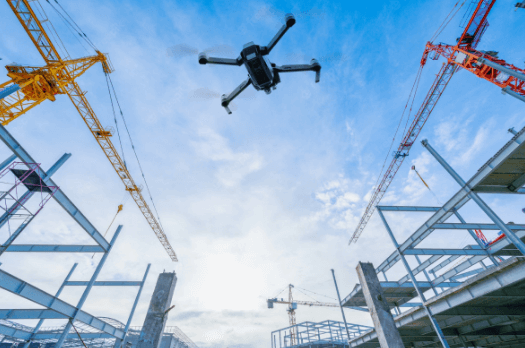Overcoming Challenges in Drone Integration for Construction Projects – Sonoran Desert Institute

Drones have revolutionized the construction industry, offering unparalleled advantages in efficiency, accuracy and safety. However, integrating drones into construction workflows is not without challenges. Sonoran Desert Institution (SDI), which is accredited by the Distance Education Accrediting Commission (DEAC), recognizes that factors such as regulatory compliance, unpredictable weather conditions and managing large volumes of data can pose significant hurdles. Addressing these issues requires strategic planning, skilled operators and robust systems to maximize the benefits of drone technology. By overcoming these challenges, construction companies can fully leverage drones to enhance project outcomes and stay competitive in an evolving industry.
Navigating Regulatory Compliance
Regulatory compliance is one of the most significant barriers to drone integration in construction projects. Different countries and regions have varying laws governing drone operations, including licensing requirements, restricted airspace zones and safety protocols. Non-compliance can result in fines, project delays or even legal action, making it essential for construction companies to understand and adhere to applicable regulations.
To mitigate these challenges, companies should invest in training and certification programs for drone operators. Certified operators are not only familiar with local regulations but also skilled in safe and efficient drone operation. Staying up to date with evolving drone laws is also critical, as governments frequently update their guidelines to keep pace with technological advancements.
Additionally, obtaining necessary permits for flying drones in restricted areas should be a priority during the project planning phase. Partnering with legal experts or consultants who specialize in drone operations can further streamline compliance, ensuring that projects proceed without regulatory disruptions.
Managing Weather-Related Challenges
Weather conditions are a significant factor affecting drone operations. High winds, heavy rain, extreme temperatures and low visibility can compromise a drone’s performance and safety. Construction projects, which often take place outdoors, are particularly vulnerable to weather-related disruptions.
To address these challenges, construction teams should incorporate weather monitoring into their drone operation plans. Advanced weather forecasting tools can help identify optimal times for drone flights, reducing the risk of interruptions or accidents. Additionally, selecting drones built to withstand harsh conditions, such as those equipped with weatherproofing features, can improve reliability.
Operators must also be trained to handle unexpected weather changes. For instance, in the event of sudden high winds, operators should know how to navigate the drone safely back to its base. Robust contingency plans, including backup schedules for drone flights, ensure that projects stay on track despite weather challenges.
Overcoming Data Management Obstacles
Drones generate vast amounts of data, including high-resolution images, 3D maps and videos. Managing, storing and analyzing this data can be overwhelming without the right infrastructure. Inefficient data handling not only slows down decision-making but can also lead to the loss of valuable insights.
The first step in overcoming data management challenges is implementing cloud-based solutions. Cloud platforms allow for seamless data storage, sharing and access, enabling project teams to collaborate effectively in real-time. By integrating drone data with construction management software, companies can streamline workflows and ensure that insights are easily actionable.
Investing in advanced data processing tools is equally important. Artificial Intelligence (AI) and machine learning algorithms can analyze drone data quickly and accurately, identifying patterns or anomalies that might otherwise go unnoticed. These technologies simplify data interpretation, helping teams make informed decisions more efficiently.
Ensuring Operator Training and Skill Development
The success of drone integration heavily depends on the expertise of the operators. Inadequate training can lead to operational errors, accidents and inefficiencies, reducing the potential benefits of drone technology.
Comprehensive training programs are essential for equipping operators with the skills needed to navigate drones safely and effectively. These programs should cover technical aspects, such as flight controls, maintenance and troubleshooting, as well as soft skills like situational awareness and problem-solving. Regular workshops and certification renewals ensure that operators stay updated on the latest technologies and regulations.
Additionally, involving operators in project planning helps align drone operations with specific construction goals. Skilled operators who understand the broader project context are more likely to deliver accurate and relevant results, enhancing overall project efficiency.
Strategic Planning for Drone Integration
Effective planning is key to overcoming integration barriers. Projects that incorporate drone usage into their workflows from the outset are better positioned to address potential challenges proactively. This includes identifying clear objectives for drone operations, such as progress tracking, safety monitoring or material inspections and aligning them with broader project goals.
Robust planning also involves selecting the right drone technology for the project. Different drones offer varying capabilities, such as long battery life, advanced sensors or weather resistance. Choosing a drone that aligns with the project’s specific requirements minimizes operational inefficiencies and ensures optimal performance.
Collaboration among project stakeholders is equally crucial. Engaging engineers, architects, contractors and drone operators in the planning process fosters a unified approach, ensuring that drone operations complement other construction activities seamlessly.
Success Stories in Drone Integration
Despite challenges, many construction projects have successfully integrated drones into their workflows. For example, an infrastructure project in a remote area navigated regulatory hurdles by collaborating with local authorities and investing in operator training, ensuring compliance and efficiency. Another company overcame weather disruptions by using weather-resistant drones and flexible flight schedules to capture critical data during brief weather windows.
In an urban development project, cloud-based platforms and AI analytics helped streamline data management, enabling faster decision-making and resource savings. These examples highlight how proactive strategies can effectively overcome integration barriers. Sonoran Desert Institute believes that by embracing these innovations, companies can lead the way in transforming the construction landscape.
The Future of Drone Integration in Construction
As technology advances, drone integration in construction will become more seamless. Innovations like autonomous drones, AI-powered analytics and longer battery life will address challenges such as continuous monitoring and data processing. Standardized regulations will simplify compliance, encouraging broader adoption, while improved data storage and processing will enhance operational efficiency. By staying ahead of these advancements and adopting best practices, construction companies can overcome barriers, leveraging drones to boost efficiency, enhance safety and deliver superior project outcomes.
Success stories from across the industry demonstrate that overcoming these challenges is possible with the right approach. As drone technology continues to advance, construction teams will have even more opportunities to streamline their workflows and achieve new levels of precision and productivity.




